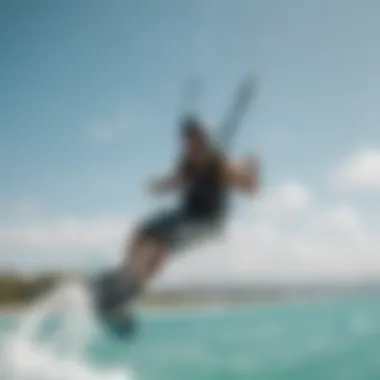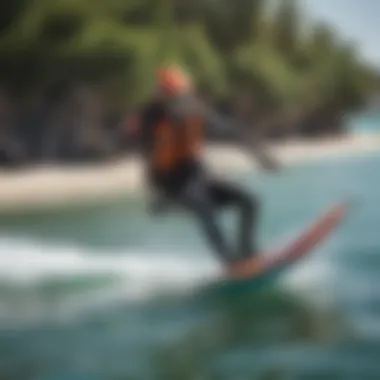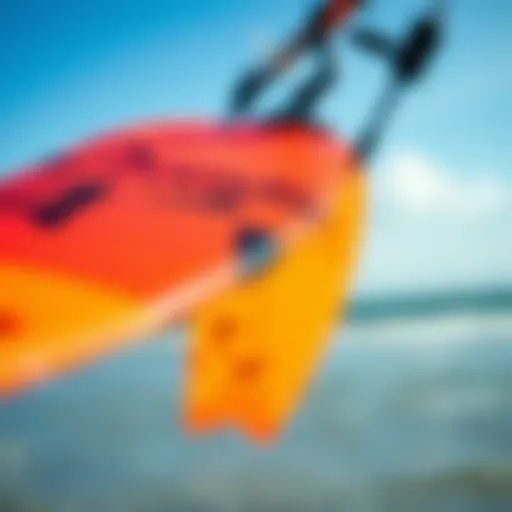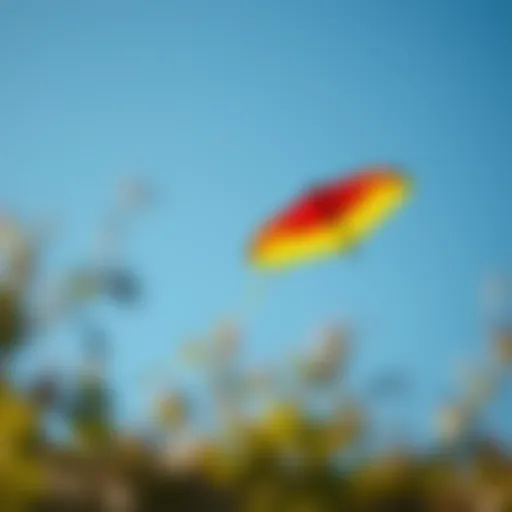Mastering Kiteboarding: Top Techniques and Destinations


Intro
Kiteboarding, that electrifying blend of wind, water, and skill, can feel like dancing with the elements. It's not just another water sport; it captures the hearts of thrill-seekers and adventurers. This article serves as a gateway, revealing the best kiting techniques and dream destinations for every level of enthusiast. With kiteboarding’s popularity soaring, knowing the right gear and techniques can elevate your experience. Let's dive into the essentials that will not only boost your skill set but also help you find the ideal location for your next adventure.
Gear Insights
When it comes to kiteboarding, the right gear can make or break your experience. Here, we’ll sift through some critical insights that kiteboarders can benefit from.
Latest Gear Reviews
With brands constantly innovating, keeping track of the latest gear is essential. One standout product this year is the North Kiteboarding Rebel. This kite is renowned for its versatility and reliability in various wind conditions. It handles beautifully, whether you’re cruising in pure flat water or tackling waves.
Another noteworthy mention is the Duotone Neo. It has received accolades for its incredible depower feature, making it safer for both beginners and veterans. It's perfect for those who enjoy free riding and jumping.
Some More Options Include:
- Liquid Force NV: Great for those who prefer aggressive riding styles.
- Cabrinha Switchblade: Best for stability and ease, suitable for diverse conditions.
Essential Gear for Beginners
Every kiteboarder starts somewhere, and having the right equipment from the get-go is crucial. Here’s what you need to get the ball rolling:
- Kite: Choose a smaller kite as a beginner. It’s easier to control and handles gusts better.
- Board: A wide board offers more stability. The Naish Nova is a solid choice for those just getting their feet wet.
- Safety Gear: Don’t skimp on your harness and helmet. The ION Radar harness provides comfort and security as you learn.
- Lessons: Invest in a few sessions with an instructor. Investing in professional guidance ensures you’ll learn proper techniques and safety protocols more quickly.
“The right gear can turn a challenging day on the water into a symphony of skill and excitement.”
Techniques and Tips
Now that we’ve gotten gear out of the way, let’s talk about the techniques that will set you apart on the water.
Advanced Tricks and Techniques
Once you've mastered the basics, it’s time to venture into more advanced tricks. Here are a few to consider:
- Jumping: Start small. First, focus on getting the timing right with your kite and landing safely.
- Transitioning: This trick involves smoothly changing directions. It’s not only stylish but also improves your skills in wind handling.
- Handle Passes: Advanced riders can practice this. It requires letting go of the kite's handles mid-air and grabbing them again during the jump.
Safety Practices for Kiteboarders
Kiteboarding isn’t without risks. Here are safety measures to keep your ride secure:
- Check Weather Conditions: Knowing wind patterns is key. Always be cautious of sudden weather changes.
- Use a Quick Release System: This feature is vital for instant kite control if things go south quickly.
- Buddy System: Whenever possible, kite with a friend. Not only is it more fun, but it also ensures someone’s there to help in case of emergencies.
By following these guidelines and insights, you’ll be equipped to enjoy kiteboarding to its fullest. With the right blend of gear and techniques, you're on the path to not just experiencing the sport but mastering it. Keep in mind, kiteboarding is as much about skill as it is about fun. Happy kiting!
Understanding Kiteboarding
Kiteboarding, a vibrant blend of wind and water, is not just a sport; it’s an exhilarating experience that showcases human ingenuity and a connection to nature. Gaining a solid understanding of kiteboarding lays the groundwork for not only enhancing performance but also deepening appreciation for the sport’s intricacies. The thrill of harnessing the power of the wind brings together enthusiasts from varied backgrounds, united by a passion for adventure.
Moreover, understanding the fundamental components of kiteboarding is vital. This ranges from the mechanics of the kite to the behavior of the water and wind conditions. It’s like learning to dance; once you grasp the steps, you can express your unique style on the water.
The Origin and Evolution of Kiteboarding
Kiteboarding’s roots can be traced back to humble beginnings. The concept emerged over a century ago, with various cultures experimenting with kites for activities like fishing and transportation. However, the modern form of kiteboarding truly began in the late 20th century. In the 1980s, pioneers like Peter Lynn began to marry surfing concepts with kite flying, ultimately leading to the emergence of what we know today as kiteboarding.
As technology advanced, so did the sport. Rigging systems evolved, kites became more sophisticated, and safety protocols were refined—each step contributing to the vibrant community we see now. This evolution isn't just historical; it continually shapes how kiteboarding is approached today.
Key Elements of Kiteboarding
Understanding kiteboarding means familiarizing oneself with its essential elements.
- Kite: The heart of the sport, varied designs cater to different conditions—some lift better in low winds while others are optimized for high-speed tricks.
- Board: The rider’s connection to the water, choosing the right board affects speed and maneuverability.
- Harness: An often-overlooked piece of gear, the right harness ensures comfort and control, enabling the rider to maintain balance while under the kite’s pull.
Each component plays a critical role in the overall experience, influencing both performance and enjoyment in distinct ways.
Popularity and Cultural Impact
Kiteboarding’s rise in popularity over the past few decades is nothing short of remarkable. What once started as a niche sport has burgeoned into a global phenomenon, with millions of enthusiasts in diverse locations. This surge can be partly attributed to the growing accessibility of the sport; advancements in equipment make it easier for beginners to take to the water while seasoned veterans pursue ever-more daring feats.


Culturally, kiteboarding has woven itself into the fabric of coastal communities worldwide. Events like kiteboarding festivals foster camaraderie, while online platforms allow users to share their experiences and techniques, forming a tight-knit network of adventurers. The sport’s visuals—colorful kites dancing against the sky—can ignite passions and friendships, creating connections that transcend borders.
"Kiteboarding is more than just a sport; it's a lifestyle that connects people through shared experiences and the thrill of adventure."
By grasping these fundamental aspects of kiteboarding, individuals can better appreciate the beauty and excitement that lie within each ride, leading to a richer experience on the water.
Essential Gear for Kiteboarding
When delving into the world of kiteboarding, one effervescent truth looms large: the success of your adventures often hinges on the equipment you choose. Without the right gear, even the most stunning beaches and favorable winds won't grant you the exhilarating experiences you seek. Thus, understanding the essential gear for kiteboarding becomes the bedrock upon which your skill and enjoyment are built.
Kites: Types and Selection Criteria
One cannot understate the significance of kites in the kiteboarding realm. They are not merely colorful fabrics gliding across the skies; they are your lifeline to the wind. Kites come in various types, tailored for distinct conditions and riding styles. For instance, a bow kite, with its forgiving qualities and easy relaunching, might suit beginners well. In contrast, a C-kite, known for its high performance and trick potential, may appeal to seasoned riders chasing adrenaline highs.
Choosing the right kite hinges on several factors:
- Skill Level: Beginners should prioritize stability and ease of handling.
- Wind Conditions: Understanding the wind strength and consistency is vital. A smaller kite works better in high winds, whereas larger kites are ideal for lighter breezes.
- Riding Style: Freestyle enthusiasts might lean towards kites that provide high lift, while those cruising may opt for kites that offer smooth riding experience.
Boards: Matching Style and Skill Level
Kiteboards, often overshadowed by kites, are pivotal for control and maneuverability. The type of board you select should align with your unique riding style and proficiency. Twin-tip boards offer versatility, allowing you to ride in both directions, making them a favorite for many riders.
While purchasing a board, consider:
- Size of the Board: Lighter riders might benefit from smaller boards, while those with a heftier build may prefer larger options for improved stability.
- Riding Styles: Freeride boards favor cruising and smooth rides, while freestyle boards are designed for tricks. Wave boards, on the other hand, excel in ocean swells.
- Skill Level: Beginners should look for boards that provide ample buoyancy, aiding in an easier ride as they become accustomed to the sport.
Harnesses: Importance in Comfort and Control
An oft-overlooked piece of gear, the harness, plays a crucial role in both comfort and control while kiteboarding. The harness attaches securely to your body, holding the kite lines in place, thus allowing you to use your core muscles rather than relying solely on your arms. A well-fitted harness enhances your performance significantly.
There are two main types of harnesses:
- Waist Harness: This is a popular choice, providing flexibility while maintaining comfort.
- Seat Harness: Ideal for beginners or those who enjoy a lower center of gravity.
Your selection should factor in:
- Fit: Ensure it's snug but not overly restrictive.
- Padding: Look for harnesses with ample padding for long rides.
Safety Equipment: Gear for Protection
Finally, together with the exhilarating moments you create on the water, safety should forever remain your utmost priority. Implementing the correct safety equipment might just be the difference between a minor mishap and facing severe consequences. Essential gear includes:
- Impact Vest: Offers primary buoyancy and protects against falls.
- Helmet: Vital for safeguarding your head from unexpected impacts.
- Safety Leash: Keeps you connected to the kite in case of emergencies, ensuring that it doesn’t fly away from you.
- Cutaway Tool: In situations where lines become tangled, a cutaway tool can save both your kite and your life.
"Preparation and precaution are your best friends on the water."
Techniques for Optimal Performance
Kiteboarding requires more than just having the right gear; it demands a fine-tuned mastery of various techniques that can elevate one's experience on the water. The importance of honing these skills cannot be understated. Whether you are a novice just starting out or a seasoned rider looking to add flair to your repertoire, optimizing your performance lays the groundwork for safety, enjoyment, and progression in this exhilarating sport.
Fundamental Skills for Beginners
For those dipping their toes into the kiteboarding arena, mastering fundamental skills is paramount. These basics form the backbone of your kiting journey.
- Understanding Kite Control: Familiarizing yourself with the kite's movements and how it responds to input is crucial. This involves positioning the kite in different wind windows and learning how to steer effectively. A solid grasp on kite control not only ensures a smooth takeoff but also helps in managing your descent.
- Body Positioning: Your stance matters immensely. Maintaining a low, balanced position on the board while keeping knees slightly bent can absorb impact and provide stability. This base enhances your control and responsiveness, especially in choppy waters.
- Launching and Landing: Practicing launching and landing your kite on land first helps build confidence. This skill is essential for safety and is best learned on a windless day or with a buddy for assistance.
"Every great kiteboarder started where you are today—by mastering the basics."
These skills create a strong platform for the more advanced tricks and maneuvers that lie ahead.
Advanced Tricks and Maneuvers
Once you've laid the groundwork of basic skills, it’s time to strap on and aim higher with advanced maneuvers. This is where individuality and creativity come into play in kiteboarding.
- Jumping Height: The thrill of catching air is a kiteboarder's dream. Learning how to generate lift involves using the power of the kite in combination with your body's movements. Loading your edge, then popping up as you release the tension can push you into the sky.
- Rotations: Mastering tricks like a 360 or handle pass not only looks impressive but adds an element of sportsmanship to your riding. Breaking down the steps and practicing them repetitively can lead to smooth landings.
- Board Off Tricks: Removing the board mid-air showcases your skills and adds creativity. This aesthetic aspect is what separates the good from the great.
As with any sport, these tricks can take time to achieve, but persistence pays off.
Common Mistakes to Avoid


Even the most experienced kiteboarders can miss the mark. Here are some common mistakes to be aware of:
- Ignoring Wind Conditions: Failing to adapt your movements to changing wind can cause issues. Always assess the conditions and adjust accordingly to avoid rough waters.
- Neglecting Safety Measures: Forgetting safety equipment or failing to use a quick-release mechanism can lead to dangerous situations. Safety should be your first priority.
- Comparing Yourself to Others: Kiteboarding is about personal growth. Every rider progresses at their own pace. Focus on your journey instead of trying to keep up with others.
- Overestimating Your Ability: Jumping into advanced techniques without solidifying foundational skills can lead to injury and frustration. Always ensure you’re ready before attempting complex tricks.
By keeping these considerations in mind, kiteboarders can glide through their waters with confidence, ensuring each outing is not just about performance, but also about developing a love for the sport itself.
Ultimately, mastering kiteboarding techniques fosters a deeper connection to the sport. As skills advance, so does the joy in every leap, turn, and ride.
Choosing the Right Location
Choosing the right location for kiteboarding isn’t just a simple matter of preference; it can make or break your experience on the water. Ideal spots can enhance your skills, minimize risks, and elevate your overall enjoyment. Each diverse location comes with its own blend of wind conditions, wave sizes, and environmental factors that cater to various adventure needs. When making a choice, consider aspects such as accessibility, safety, and local culture. A good location can also enhance your opportunities to connect with other kiteboarders, forging valuable relationships within this spirited community. Ultimately, the right spot is more than just a backdrop. It’s about creating unforgettable memories while perfecting your kiteboarding maneuvers.
Criteria for Selecting Kiteboarding Spots
When eyeing potential kiteboarding spots, several criteria must be assessed:
- Wind Strength and Consistency: Look for areas that experience steady winds. This can vary by season, so check local weather patterns.
- Water Conditions: Flat water is ideal for beginners, while waves attract seasoned riders looking for adrenaline highs. Assess what you’re most comfortable with.
- Safety Features: Examine the spot for obstructions, like rocks or busy beaches, that could pose danger.
- Accessibility: Some locations are remote and can be difficult to reach. It pays to factor in how easy it is to get there and whether there are necessary amenities nearby.
- Local Conditions: Familiarize yourself with the area’s tide patterns and currents to gauge how challenging the water might be.
Top Kiteboarding Destinations
Caribbean Hotspots
The Caribbean is often the crown jewel for kiteboarders, known for its spectacular beauty and inviting weather. Its clear, turquoise waters and consistent trade winds provide perfect conditions for both novices and veterans alike. Some beaches, like Cabarete in the Dominican Republic, stand out for their gentle, yet powerful winds.
Key Characteristic: Frequent wind patterns make it a reliable destination year-round.
Unique Feature: The vibrant nightlife and local culture present additional allure. For many riders, kiteboarding in the Caribbean becomes a summer vacation rather than just a sport. However, popularity also brings an increased crowd which could possibly lead to busy water sports areas, demanding careful navigation.
European Gems
Europe is home to diverse kiting landscapes, from the windswept shores of the UK to the sunny bays of Spain. Locations like Tarifa in Spain are regarded as the kitesurfing capital of Europe, thanks to its strong winds and varied conditions catering to every skill level.
Key Characteristic: Easy travel access for Europeans means more riders can converge here during peak seasons.
Unique Feature: Historical backdrops in spots like Dakhla, Morocco add a cultural twist to a sport that thrives on adrenaline. The downside? The weather can be quite unpredictable, and planning might require more flexibility.
North American Favorites
Locations such as Cape Hatteras in North Carolina provide a unique coastal setting that attracts kiteboarders from all over. This spot offers the added bonus of expansive flat water in the sound and challenging waves in the ocean, which caters to different skill sets.
Key Characteristic: A combination of fresh air, stunning landscapes, and kiteboarding-friendly conditions makes it appealing.
Unique Feature: The local kiteboarding community is often tight-knit and welcoming, fostering an inviting atmosphere for newcomers. However, one must consider that the peak summer months can mean battling for space on the water, so it’s vital to know your time and place.
Emerging Locations in Asia
Asia is witnessing a surge in kiteboarding popularity with spots like Mui Ne in Vietnam gaining traction. Known for its steady winds and beautiful scenery, it is quickly becoming a destination to watch.
Key Characteristic: Affordability makes it an attractive alternative for those looking to kiteboard without breaking the bank.
Unique Feature: Stunning natural backdrops and local surf culture contribute to an enlightening experience that diverges from typical tourist traps. On the flip side, the infrastructure in some regions may not be fully developed, so it’s wise to plan equally well for comfort and convenience.
Understanding Local Conditions
Understanding local conditions is essential in mastering kiteboarding at any given location. A comprehensive grasp of wind patterns, tide shifts, and the topography of the water enables better preparation and performance. Pay attention to local advisories and forecasts, and always stay alert to change. Kiteboarding is as much about timing and adaptability as it is about skill.
"A kiteboarder’s adaptability to local conditions can determine their level of skill and enjoyment on the water."
Ultimately, acknowledging these elements equips you with more than just knowledge; it helps build a foundation for safe and fun kiteboarding adventures.
Kiteboarding Community and Culture
Kiteboarding is more than just a sport; it's a vibrant tapestry of connections, shared experiences, and unique narratives. At its heart lies a community bound by a passion for the thrill and freedom that comes with harnessing wind and water. The culture surrounding kiteboarding transcends mere recreational activity, evolving into a lifestyle that fosters camaraderie among enthusiasts, whether they are beginners or seasoned pros. This section delves into the essence of the kiteboarding community, highlighting its significance and the benefits it brings to those who participate.
Building Connections within the Kiteboarding Community
Establishing friendships in the kiteboarding world can happen in the blink of an eye. Whether it's at a local spot or during a globetrotting adventure, kiteboarders naturally bond over their shared love for the sport. These connections are often forged during lessons, competitions, or even casual sessions at the beach. The synergy between riders creates an inclusive atmosphere where tips and experiences are exchanged freely.


The sense of belonging one experiences can be remarkable. Many find themselves participating in local kite clubs, where they can meet fellow enthusiasts regularly. Some examples include community meet-ups for collective riders' days, or even social media groups where kiteboarders share photos, advice, or arrange meet-ups. These gatherings can turn into lifelong friendships, making it easier to conquer new challenges and grow in the sport together.
User-Generated Content and Storytelling
In today's digital age, storytelling has been revolutionized by social media. User-generated content plays a vital role in showcasing the thrill of kiteboarding and its culture. From daily sessions captured on cameras to engaging blogs about dramatic adventures in remote locations, the narratives shared by kiteboarders enrich the community’s fabric.
For instance, platforms like Facebook and Reddit provide spaces for enthusiasts to discuss techniques, share their stories, and celebrate their achievements. The stories can range from a beginner's first upwind ride to an epic trip across an exotic destination. These testimonials are invaluable; they inspire others and make the sport feel more accessible to newcomers, igniting their excitement for kiteboarding.
With visually stunning images and witty captions, which you often find on Instagram, kiteboarding experiences come alive online. They help demystify the sport for the uninitiated, allowing them to see how approachable and enjoyable kiteboarding can be.
Events and Competitions in Kiteboarding
Events and competitions serve as critical gatherings within the kiteboarding culture, building bridges between riders from all walks of life. Whether it's a local contest or a world championship, these events create opportunities for kiteboarders to connect, learn, and often push the boundaries of their abilities.
Participation in such competitions can be exhilarating. Even those who aren't competing firsthand often benefit by observing top riders and picking up valuable insights. Additionally, competitions highlight the diversity in styles and skill levels present in the kiteboarding community. From freestyle to wave riding, an array of disciplines showcases talent and fosters respect among participants.
The camaraderie extends beyond the competition itself; post-event celebrations and social gatherings allow riders to relive the day’s excitement, swap stories, and deepen their relationships.
In summary, the kiteboarding community and culture form an intricate web of connections, narratives, and experiences that play a crucial role in enhancing the sport. By building relationships and sharing stories, enthusiasts not only deepen their understanding of kiteboarding but also create lasting bonds that enrich their adventures on the water.
"Kiteboarding is not just about the sport; it's about the people you meet along the way."
Engaging with the community can significantly magnify the joys of kiteboarding and pave the way for both personal growth and unforgettable adventures.
Health and Safety Considerations
In the exhilarating realm of kiteboarding, the thrill of skimming over water and catching air can often overshadow the essential need for health and safety. This segment highlights the importance of being conscious about personal safety while kiteboarding. Not only does it protect participants from potential accidents, (which can range from minor injuries to life-threatening situations), but it also fosters a culture of responsibility and respect within the kiteboarding community.
Understanding how to minimize risks is as crucial as mastering the latest tricks. When kiteboarding, you are subject to various environmental factors which can be unpredictable. Wind conditions, water currents, and changing weather can all influence a session on the water. Therefore, an awareness of these hazards ensures not only personal safety but the safety of others riding in the vicinity, making it a priority to adopt good practices.
Essential Safety Practices
Keeping safety top of mind translates into a few key practices:
- Pre-Flight Checks: Always inspect equipment before heading out. Make sure the kite, lines, harness, and board are in good shape. Deterioration or damage can lead to catastrophic failures.
- Learn and Use Safety Systems: Familiarize yourself with the kite's safety release systems. In case of an emergency, knowing how to quickly detach yourself from the kite can be a lifesaver.
- Understand Your Limits: It's tempting to pursue advanced maneuvers, but understanding where your skills lie is vital. Pushing boundaries can lead to accidents.
- Use a Spotter: When possible, kite with a buddy who can provide assistance. This is especially important for beginners who might struggle initially.
- Wear Safety Gear: Helmets and impact vests can significantly reduce injury risks from falls, providing both protection and peace of mind.
Remember, putting safety first will maximize enjoyment and minimize risks on the water. (Adding extra measures alongside these practices will ensure you can ride more freely, knowing that you've taken steps to mitigate danger.)
"Safety is not just a priority; it's a commitment to yourself and others in the kiteboarding world."
Environmental Considerations
Kiteboarding isn't just a sport; it’s an adventure that connects people to nature. However, with great enjoyment comes a responsibility to protect our environment. Kiteboarders are often out in pristine spots that can be fragile ecosystems. Understanding environmental considerations is fundamental to preserving the beauty of these locations for generations to come.
Here are key points to keep in mind:
- Respect Wildlife: Many kiteboarding spots may be home to local wildlife. Maintain a safe distance and avoid nesting areas, especially during breeding seasons.
- Leave No Trace: Dispose of waste responsibly. Bring back any rubbish you generate, and if possible, clean up after others. This small effort significantly impacts maintaining clean and beautiful spots.
- Educate Yourself on Local Rules and Regulations: Different locations have their own guidelines. Familiarizing yourself with them not only protects you from potential fines but also the environment.
- Practice Sustainable Kiteboarding: Whenever possible, utilize eco-friendly gear. Many companies are making strides towards sustainable materials in kiteboarding equipment. Supporting these initiatives can lessen your environmental impact.
Fostering a strong connection to nature through conscious choices not only enhances the kiteboarding experience but also contributes to the preservation of the idyllic places where our sport flourishes. By blending safety with environmental considerations, kiteboarding can continue to be a thrilling yet responsible venture.
The Future of Kiteboarding
The horizon of kiteboarding is as vibrant and unpredictable as the ocean winds that propel riders across the waves. As technology advances and global awareness of environmental impacts grows, the landscape of this exhilarating sport is set to evolve dramatically. Understanding these shifts is crucial for kiteboarders—whether novice or expert—looking to stay ahead of the curve. This section will explore pivotal innovations and ethical practices that not only enhance the kiteboarding experience but also contribute to the sustainability of the sport.
Technological Innovations
In recent years, the kiteboarding industry has seen a surge in technological advancements that have significantly shaped performance and accessibility. For one, the introduction of lightweight materials such as ripstop nylon has made kites more durable and easier to handle. This innovation allows kiteboarders to enjoy longer sessions without the worry of equipment failure.
Moreover, control systems have become more sophisticated. With the integration of smart technology into kiteboarding gear, riders can now access data on wind conditions and kite performance directly from their smartphones via Bluetooth-enabled devices. This allows for real-time adjustments and enhances the overall riding experience.
Another interesting innovation is the development of foil kites. These kites are designed to glide smoothly over the water, enabling riders to experience less drag and thus, a quicker ride. Such kites are particularly advantageous for speed enthusiasts looking to push boundaries. Not only do these trends highlight the rapid strides in kite technology, but they also hint at an exciting future for both recreational and competitive kiteboarding.
"Innovation is the key to staying ahead in kiteboarding, as gear becomes smarter, enhancing both safety and performance for all skill levels.”
Sustainable Practices in the Sport
As kiteboarding gains popularity, the responsibility of its practitioners to protect the environments they enjoy becomes increasingly pertinent. Sustainable practices within the sport are not only important for ensuring the longevity of its natural playgrounds but also resonate with a growing number of eco-conscious riders.
From gear manufacturing to waste management, various initiatives are emerging. For instance, some brands are now utilizing recycled materials in their kites and boards. This isn’t just a trend; it’s becoming a standard, proving that the future can be both thrilling and eco-friendly. Additionally, manufacturers are working to create biodegradable materials that break down more harmlessly than traditional plastics.
Community-led efforts also play a critical role in promoting sustainability in kiteboarding. Many local kiteboarding clubs are organizing clean-up days at popular spots, ensuring that beaches and waters remain pristine for future generations. By establishing educational programs, they aim to instill a sense of environmental stewardship among riders.
As kiteboarding continues to expand, bridging the gap between adventure and conservation will be essential. The community's commitment to sustainable practices could secire a flourishing future for the sport, keeping it in harmony with nature.
By embracing technological innovations and sustainable practices, kiteboarding not only reshapes its identity but also strengthens its community ties and environmental consciousness. Proactive adaptation to these changes will ensure that kiteboarding remains a thrilling pursuit for years to come.















